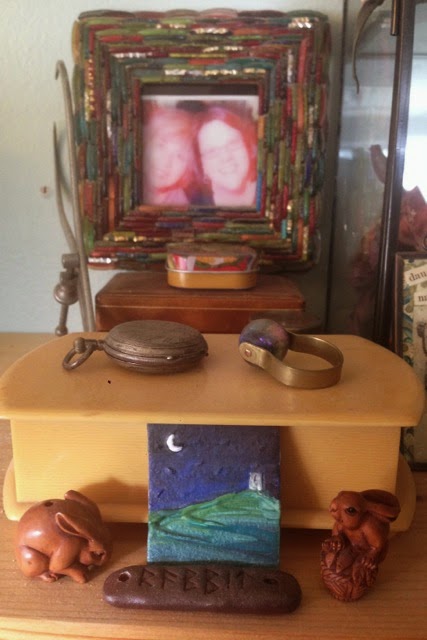Happy Halloween! Feliz Dia de los Muertos!
 |
| Dia de los Muertos ofrenda table, San Diego. Photo by J. Davies-Reazor |
 |
| last years skulls |
I make a batch every October, for friends, and fall shows. I'll work on them over a few days: sculpt, cure, paint, cure, bead... This year I was teaching a Sugar Skull workshop as well. I was faced with the challenge of streamlining my process down to an hour and a half. I wanted the students to leave wearing their cured/finished pendant. So how to color and embellish the raw clay and do one simple cure at the end of class? My skulls are usually multiple layers of oils and acrylics, Gilders paste, sealed for durability... Hmm.
And I like to add variety to each batch. New tools, new techniques...
This year's new tool set: leather stamps. I found these on Amazon, pretty cheap, and since I won't be hammering them into leather repeatedly, thought they would do nicely. They are perfect! I love the striped crescent moon shapes especially.
Naked skulls - a combination of small decorative rubber stamps and the leather stamps. Flower eyes! Heavens! Its too good! I am in love.
Now I mentioned that whole pesky workshop time constraint. Well - the colorant I like to use on raw clay is Mica powder. I have a few colors, they are easy to apply, and cure into the clay. They would be perfect for a single cure piece as color, and decoration.
Brushed on they are a total scary what-have-i-done? mess.
With the surplus gently blown away, they are less scary, but still smeared and a bit all over the place. The trick to clean up? Clear tape. ( Sorry there isn't a video tut of this. If I could figure out how to hold the camera with my chin... ) Simply use the sticky side, gently pressed on surface, to remove excess powder. Powder remains in the impressed areas. Viola!
These four are cleaned up and ready for the toaster oven. Wire loops are in the foreheads for jump ring/beading later. Czech glass flowers are applied with a head pin. (Bent at end to prevent it from pulling out. ) There are a few areas I will clean up with a little wet sanding...
And here is the motley crew waiting to be whisked off to FaerieCon next weekend!
The class, you ask? Fabulous! See what my students made:
 |
| Student work left and center. ( Mine on right) They got theirs done! |






















































.jpg)
.JPG)
.jpg)
